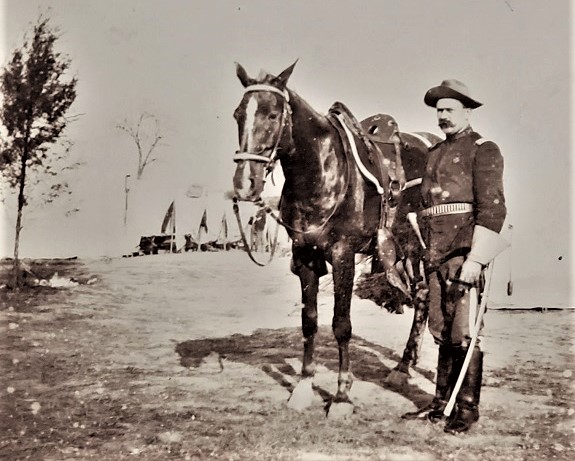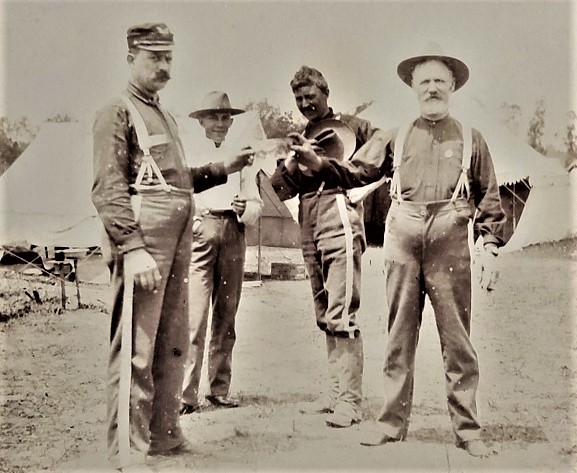


The following is a brief history of the 7th Ohio Volunteer Infantry. The unit served its term of service within the continental U.S.
The History:
The 7th Ohio Volunteer Infantry was mustered into service between May 13 and June 30, 1898 at Columbus, Ohio. That the time of mustering in, the regiment consisted of forty-nine officers and 872 enlisted men.
While recruiting was still ongoing to fill out the regiment, the mustered portion of the Seventh Ohio Volunteer Infantry was ordered to Camp Alger, at Dunn Loring, Virginia, near Washington DC. The camp was named for the Secretary of War, Russell Alger. The regiment left Columbus on May 18, and arrived at Camp Alger three days later. At Camp Alger, the regiment was assigned to the First Brigade, First Division of the Second Army Corps. By late July, the regiment was encamped near teh Crittenden Farm at the Camp. While the regiment was at the camp, Spain and the U.S. reached an armistice, ending the war's fighting. The regiment apparently had suffered from complaints concerning the mens' condition, an issue with most volunteer regiments at this time. In response, On August 21 Governor Grosvenor of Ohio paid a visit to the regiment' camp to view the conditions there. He noted that "I never saw a body of soldiers better fed, better clothed and better sheltered than is the Seventh Ohio at present." He attributed the complaints mainly to the regiment's not getting sent to the front. In short, the complaints stemmed from the boredom and dangers of disease etc., inherent in camp life. While at Camp Alger, in July, three men drank "wood alcohol" which resulted in the death of soldier named Kimbark and sickened two others that were not expected to survive. Governor Grosvenor also alluded to a soldier who committed suicide. Obviously morale must have been quite low.
Amid reported cases of typhoid within the regiment, On September 1, 1898, the 7th Ohio was ordered north, to Camp Meade, a new army camp located at Middletown, Pennsylvania, near the state capital of Harrisburg. The 7th Ohio was only at Camp Meade for twenty days, being ordered back to Columbus, Ohio and departing Camp Meade on September 22. On September 27, the men of the regiment were given a thirty day furlough.
The regiment was finally mustered out of service on November 6, 1898 at Columbus. At the time of mustering out, the regiment consisted of forty-nine officers and 1,117 enlisted men. During its term of service, it lost 1 officer and 5 enlisted men to disease, and had one enlisted man desert. In addition, thirty-six enlisted men were discharged on disability. The war officially ended a little over a month later with the signing of the Treaty of Paris, on December 10, 1898.
The regiment's battles did not end with their mustering out. Many of the men within the regiment had apparently taken issue with Colonel Arthur L. Hamilton, the regiment's commander. Two days after the regiment was mustered out, the colonel came upon four men of his former command having dispute in front of residence. When he attempted to mediate, he was attacked by the men, and was given a "severe drubbing." Two other soldiers - Sam Story and Fred Gettle - came to his aid and rescued him. Hamilton later could be seen (as his image, his wife's image and his endorsement) in newspaper ads advocating a medicine called "Pe-ru-na"
Also, in September of 1898, almost a year after the regiment went out of existence, its former chaplain, John M. Life was expelled from the ministry for having used disrespectful language to the daughter of the regiment's lieutenant colonel in the late summer of 1898. Life appealed the expulsion.

Non-commissioned officers of the 7th Ohio Volunteer Infantry joking around. The photo is entitled "Last Dollar in Camp." Two of the non-commissioned officers hold the dollar while another, behind them, covers his heart with his hat.
"A Brave Colonel," The Freeborn County Standard. (Albert Lea, Minnesota, March 29, 1899) 2.
"A Minister Expelled," The Fresno Weekly Republican. (Fresno, California, September 8, 1899) 7.
"Colonel," The Marion Daily Star. (Marion, Ohio, November 8, 1898) 1.
Correspondence relating to the War with Spain And Conditions Growing Out of the Same Including the Insurrection in the Philippine Island and the China Relief Expedition. Vol. 1 (Washington: Government Printing Office, 1902) 611.
"Full of Praise," The Marion Daily Star. (Marion, Ohio, August 31, 1898) 2.
"Moving," The Marion Daily Star. (Marion, Ohio, July 25, 1898) 2.
Peacock, Marcus - Image of Maj. Wiedler and Last Dollar in Camp
"Several Deaths," The Marion Daily Star. (Marion, Ohio, July 25, 1898) 1.
Statistical Exhibit of Strength of Volunteer Forces Called into Service During the War with Spain; with Losses from All Causes. (Washington: Government Printing Office, 1899).
"Typhoid," The Marion Daily Star. (Marion, Ohio, September 1, 1898) 1.